By Rootz - 3/25/2012 9:05:21 PM
Hiya!
I'm Andy. From St Albans. I'm into RC car speed records. Would you believe the current World Record is about 160mph. I say "about" cos it's changing all the time. There are two competitors who are vying to become the first to break the 300kmh and 200mph barriers right now.. If you're interested in that kinda thing, take a look at these sites: http://iscspeedchallange.forumotion.com/http://www.fast-rc.co.uk/forum/index.phphttp://fastestrc.blogspot.co.uk/Anyway, my ambitions are a tad less extreme. I have several RC cars but this year, I'll be campaigning a 10th scale dragster and a 1/14th scale 4WD streamliner, based on a Sportwerks Recoil. Our sport is no stranger to composites. RC racing cars have used CNC-cut 2-4mm CF for chassis for quite a few years and those that don't, have chassis and suspension components injection moulded from CF and graphite-filled plastics. RC racing car bodyshells usually are made from vacuum moulded Lexan, which is very light and fairly strong but isn't really up to scooting along upside down on tarmac at 100mph and also tends to flex under vibration and aero forces. The usual solution is to buy a shells that's close to what you want and modify, reinforce etc, it. Long story short, I've decided to start building my own bodies using composites. They might ( or not! ) be a little heavier than Lexan but I'm hoping they'll be more robust and I'm attracted to the complete design flexibility the process offers. So! First the 1/14th scale streamliner. Last year, I built a body based on a fibreglass "drop tank". It's basically tear-drop shaped and I cut out holes for the wheels and a 2mm CF tail plane stuck on the back. 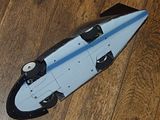 I ran that at one meeting and had good results. Using some newly acquired metal beating skills, I made up some 20 gauge ally wheel fairings which were screwed to the GRP body. 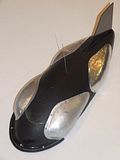 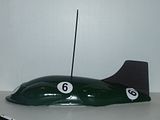  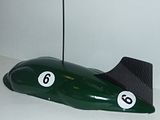 The result was pretty good but the shell was pretty heavy. 330 grammes may not seem much, 30g of which was M2 screws and nuts, but when the whole car weighs in at less than 1100g, I felt I could make an improvement. So!! ( He says, finally getting to the point! )... Here's the progress I've made in the last week or so.. 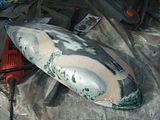 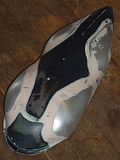 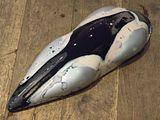 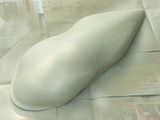  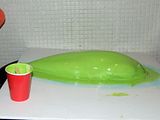 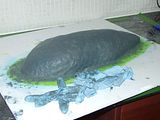 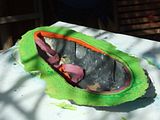 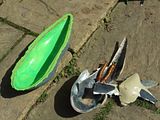  As you might expect, I used the EasyComposites Epoxy Mould Making Starter Kit and, I must say, It all went together pretty well. The real hard work was rubbing down and surfacing the original. I used Isopon for filling, High-Build primer to get a good surface and a fantastic aerosol 2K clear coat from Specialist Paints.. http://www.specialistpaints.com/custom-aerosol-cansWell, considering this whole thing has been done in my garden and kitchen, I'd say things are looking pretty positive. The kit worked very well. The instructions ( and video ) were as clear as you could ever want. I managed to dye my finger tips with the PVA, the mould making putty came out at 650g, not 750 so the mould's only about 7mm thick but it's easily tough enough. two of the gloves split, which was a bit messy but after a couple of days of wet'n'dry, who cares! The plan is to lay up my first body this week. I'm planning to make it with killer whale patterns - It's called "Root'z Shamu" - Idea is to use Alufibre for the white bits and Pro Finish for the black bits with the kit CF and a few bits of Kevlar for the inside. I'm hoping to make it as thin as possible - Perhaps 0.5mm. Question: How many layers would make up 0.5mm?? Anyway. Many thanks for reading this far. Hope it was fun and I look forward to chatting with people on here in the future. Cheerz! R  t tz
|
By neilb - 2/12/2013 8:45:34 AM
sorry about the first pic, bit big!!! could someone remove that?

good luck with the project, keep us posted...
|
|